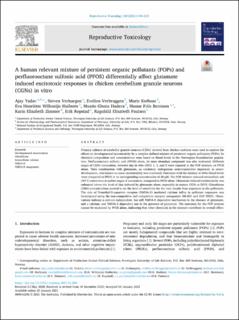| dc.contributor.author | Yadav, Ajay | |
| dc.contributor.author | Verhaegen, Steven | |
| dc.contributor.author | Verbruggen, Evelien | |
| dc.contributor.author | Kerhoas, Marie | |
| dc.contributor.author | Huiberts, Eva Henriëtte Willemijn | |
| dc.contributor.author | Hadera, Mussie Ghezu | |
| dc.contributor.author | Berntsen, Hanne Friis | |
| dc.contributor.author | Zimmer, Karin Elisabeth | |
| dc.contributor.author | Ropstad, Erik | |
| dc.contributor.author | Paulsen, Ragnhild Elisabeth | |
| dc.date.accessioned | 2021-09-16T11:34:21Z | |
| dc.date.available | 2021-09-16T11:34:21Z | |
| dc.date.created | 2021-02-08T13:57:54Z | |
| dc.date.issued | 2021 | |
| dc.identifier.citation | Reproductive Toxicology. 2021, 100 109-119. | |
| dc.identifier.issn | 0890-6238 | |
| dc.identifier.uri | https://hdl.handle.net/11250/2778608 | |
| dc.description.abstract | Primary cultures of cerebellar granule neurons (CGNs) derived from chicken embryos were used to explore the effects on developmental neurotoxicity by a complex defined mixture of persistent organic pollutants (POPs). Its chemical composition and concentrations were based on blood levels in the Norwegian/Scandinavian popula-tion. Perfluorooctane sulfonic acid (PFOS) alone, its most abundant compound was also evaluated. Different stages of CGNs maturation, between day in vitro (DIV) 1, 3, and 5 were exposed to the POP mixture, or PFOS alone. Their combination with glutamate, an excitatory endogenous neurotransmitter important in neuro-development, also known to cause excitotoxicity was evaluated. Outcomes with the mixture at 500x blood levels were compared to PFOS at its corresponding concentration of 20 μM. The POP mixture reduced tetrazolium salt (MTT) conversion at earlier stages of maturation, compared to PFOS alone. Glutamate-induced excitotoxicity was enhanced above the level of that induced by glutamate alone, especially in mature CGNs at DIV5. Glutathione (GSH) concentrations seemed to set the level of sensitivity for the toxic insults from exposures to the pollutants. The role of N-methyl-D-aspartate receptor (NMDA-R) mediated calcium influx in pollutant exposures was investigated using the non-competitive and competitive receptor antagonists MK-801 and CGP 39551. Obser-vations indicate a calcium-independent, but still NMDA-R dependent mechanism in the absence of glutamate, and a calcium- and NMDA-R dependent one in the presence of glutamate. The outcomes for the POP mixture cannot be explained by PFOS alone, indicating that other chemicals in the mixture contribute its overall effect. | |
| dc.language.iso | eng | |
| dc.title | A human relevant mixture of persistent organic pollutants (POPs) and perfluorooctane sulfonic acid (PFOS) differentially affect glutamate induced excitotoxic responses in chicken cerebellum granule neurons (CGNs) in vitro | |
| dc.type | Peer reviewed | |
| dc.type | Journal article | |
| dc.description.version | publishedVersion | |
| dc.source.pagenumber | 109-119 | |
| dc.source.volume | 100 | |
| dc.source.journal | Reproductive Toxicology | |
| dc.identifier.doi | 10.1016/j.reprotox.2021.01.008 | |
| dc.identifier.cristin | 1887697 | |
| dc.relation.project | EC/H2020/722634 | |
| cristin.ispublished | true | |
| cristin.fulltext | original | |
| cristin.qualitycode | 1 | |
